
A | B | C | D | E | F | G | H | CH | I | J | K | L | M | N | O | P | Q | R | S | T | U | V | W | X | Y | Z | 0 | 1 | 2 | 3 | 4 | 5 | 6 | 7 | 8 | 9

The Roman empresses were the consorts of the Roman emperors, the rulers of the Roman Empire. The duties, power and influence of empresses varied over time depending on the time period, contemporary politics and the personalities of their husband and themselves. Empresses were typically highly regarded and respected, and many wielded great influence over imperial affairs. Several empresses at times served as regents on behalf of their husbands or sons and a handful ruled as empresses regnant, governing the empire in their own right without a husband.
There was no single official term for the position of empress in Ancient Rome. Typical Latin titles included augusta (Greek: αὐγούστα, augoústa), the female form of the male imperial title augustus, and caesaraea (Greek: καισᾰ́ρειᾰ, kaisáreia), the female form of the male imperial title caesar. In Greek, empresses could be referred to as βᾰσῐ́λῐσσᾰ (basílissa), the female form of the male title basileus (denoting a monarch) and αὐτοκράτειρα (autokráteira), the Greek version of the Latin autocratix, the female form of the male title autokrator (denoting a sole ruler). In the third century, empresses could also receive various honorific titles, such as māter castrōrum "mother of the castra" and māter patriae "mother of the fatherland". Titles such as augusta were not used by all empresses, and since such titles could also be granted to other imperial women, such as mothers, sisters and mistresses of emperors, not all women who bore the title were empresses either.
Given that there were sometimes more than one concurrent Roman emperor, there were also sometimes two or more concurrent Roman empresses. For most of the period from 286 to 480, the Roman Empire, though remaining a single polity, was administratively divided into the Western Roman Empire and the Eastern Roman Empire. Through most of this period, the separated imperial courts had their own lines of succession, and as a result their own sequences of concurrent Roman empresses. The western empire fell in the late 5th century, its final empress being the wife of Emperor Julius Nepos. The eastern empire, often referred to as the 'Byzantine Empire' by modern historians, endured for almost another millennium until its fall through the fall of Constantinople in 1453. The final empress of the east, and final Roman empress overall, was Maria of Trebizond, wife of Emperor John VIII Palaiologos. In addition to basílissa and autokráteira, many later eastern empresses bore the title δέσποινα (déspoina), the female form of the male title despotes, a common title in the later empire.
Though the constitutional power of empresses was never defined, it was generally accepted that their coronation, performed after that of their husbands, granted them some imperial power. Often, their primary duties were to oversee the organization of ceremonies at the imperial court as well as to partake in imperial and religious affairs. Although governmental power was most often vested only in the emperor, empresses could gain significant authority as regents for young children or when their husbands were absent. Though they were bound by the wishes and temperaments of their husbands, empress consorts could at times also effectively become influential co-regents. In some cases, emperors reinforced their legitimacy through marrying the daughter of a previous emperor. In such cases, empresses sometimes stressed their dynastic legitimacy, greater than that of their husbands, to achieve great influence. Several influential consorts, such as Theodora, wife of Justinian I, and Euphrosyne, wife of Alexios III, held their own courts. Empresses who ruled in their own right, such as Irene and Zoë Porphyrogenita, sometimes adopted male titles such as basileus and autokrator to illustrate their power.[1]
Principate (27 BC – AD 284)
Julio-Claudian dynasty (27 BC – AD 68)
| Portrait | Name | Tenure | Life details & notes | Emperor (spouse) | Ref |
|---|---|---|---|---|---|

|
Livia Drusilla | 16 January 27 BC – 19 August AD 14 (40 years, 7 months and 3 days) |
30 January 59 BC – AD 29 (aged 87) Daughter of Marcus Livius Drusus Claudianus; married Tiberius Claudius Nero in 43 BC and then Octavian on 17 January 38 BC. Known as "Julia Augusta" after his death; deified by Claudius on 17 January AD 42. The longest-reigning empress |
Octavian Augustus (r. 27 BC – AD 14) |
[2] |

|
Orestilla[a] | c. AD 37 (very briefly)[b] |
Second wife of Caligula; forced to marry him immediately after her marriage to Gaius Calpurnius Piso. After the divorce they were both exiled for alleged adultery. Probably the shortest-reigning empress. | Caligula (r. 37–41) |
[4] [5] [6] |

|
Lollia Paulina | c. AD 38 (a few months)[c] |
Daughter of Marcus Lollius, originally married to Publius Memmius Regulus. Forced to commit suicide | ||

|
Milonia Caesonia | Summer 39 – 24 January 41 (about 1 year and a half) |
Born on 3 June of an unknown date, married to another man before becoming Caligula's mistress. Murdered alongside Caligula and their daughter Julia Drusilla | ||

|
Valeria Messalina | 24 January 41 – AD 48 (7 years) |
Daughter of Marcus Valerius Messalla. Executed after having an affair with Gaius Silius; suffered damnatio memoriae. | Claudius (r. 41–54) |
[7] |

|
Agrippina the Younger Julia Agrippina |
1 January 49 – 13 October 54 (5 years, 9 months and 12 days) |
6 November 15 – 23 March 59 (aged 43) Daughter of Germanicus Julius Caesar and mother of Nero, named augusta in AD 50. Killed in unclear circumstances |
[8] | |

|
Claudia Octavia | 13 October 54 – AD 62 (7 years and a few months) |
39/40 AD – 9 June 62 (aged 22–23) Daughter of Claudius and Valeria Messalina. Exiled and later executed. |
Nero (r. 54–68) |
[9] |

|
Poppaea Sabina | AD 62 – AD 65 (3 years) |
30/32 AD – early Summer 65 (aged 33–35) Daughter of Titus Ollius; married Rufrius Crispinus c. 50, then the future emperor Otho in 58. Named augusta shortly after Claudia's birth in January 63, posthumously deified. | ||

|
Statilia Messalina | early 66 – 9 June 68 (2 years) |
c. 35 – c. 70 (aged approx. 35) Daughter of Titus Statilius Taurus (consul 44), married consul Marcus Julius Vestinus Atticus in AD 63/64. Married Nero after the forced suicide of her husband; suffered damnatio memoriae. |
Year of the Four Emperors (69)
| Portrait | Name | Tenure | Life details & notes | Emperor (spouse) | Ref |
|---|---|---|---|---|---|

|
Galeria Fundana | 19 April – 20 December 69 (8 months and 1 day) |
Born on 3 January of an unknown date. Daughter of a pretor; possibly related to Publius Galerius Trachalus. | Vitellius (r. 69) |
[10] |
Flavian dynasty (81–96)
| Portrait | Name | Tenure | Life details & notes | Emperor (spouse) | Ref |
|---|---|---|---|---|---|
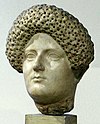
|
Domitia Longina | 14 September 81 – 18 September 96 (15 years and 4 days) |
11 February 50/55 – c. 126 (aged approx. 70–76) Daughter of general Gnaeus Domitius Corbulo, first married to senator Lucius Aelius Aelianus. Named augusta after her marriage to Domitian. |
Domitian (r. 81–96) |
[11] |
Nerva–Antonine dynasty (98–192)
All empresses of this period received the title augusta.
| Portrait | Name | Tenure | Life details & notes | Emperor (spouse) | Ref |
|---|---|---|---|---|---|

|
Pompeia Plotina | 28 January 98 – 7/11 August 117 (19 years, 6 months and 10/14 days) |
c. 70 (?) – c. 123 (aged approx. 53) Daughter of Lucius Pompeius, named augusta around 102, posthumously deified. She was interested in the Epicurean philosophical school of Athens. |
Trajan (r. 98–117) |
[12] |

|
Vibia Sabina | 11 August 117 – c. 137 (c. 20 years) |
c. 85 – 136/137 (aged approx. 52) Daughter of senator Lucius Vibius Sabinus, married Hadrian around 100, named augusta around 119, posthumously deified. |
Hadrian (r. 117–138) |
[13] |

|
Faustina the Elder Annia Galeria Faustina |
10 July 138 – late October 140 (2 years and 3 months) |
c. 97[d] – late October 140 (aged approx. 43) Daughter of Marcus Annius Verus the Elder, married Antoninus around 120, named augusta in 138, posthumously deified |
Antoninus Pius (r. 138–161) |
[15] |
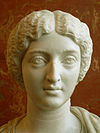
|
Faustina the Younger Annia Galeria Faustina |
7 March 161 – 175 (14 years) |
c. 130[d] – 176 (aged approx. 46) Daughter of Antoninus Pius, betrothed to Lucius Verus on 25 February 138, married Marcus Aurelius on 13 May (?) 145. Named augusta on 1 December 147 and mater castrorum (mother of the castra) in 174, posthumously deified. |
Marcus Aurelius (r. 161–180) |
[16] |

|
Lucilla Annia Aurelia Galeria Lucilla |
163 (?) – 169 (6 years) |
7 March 149 – 181/182 (aged 32–33) Daughter of Marcus Aurelius, betrothed to Lucius Verus in 161, named augusta shortly after the marriage. Exiled to Capri and executed by Commodus. |
Lucius Verus (r. 161–169) |
[17] |

|
Bruttia Crispina | 178 – 191/2 (3–4 years) |
Daughter of Gaius Bruttius Praesens (consul 153), named augusta after her marriage with Commodus, sometime before 3 August 178. Exiled to Capri for alleged adultery and executed soon after; suffered damnatio memoriae. | Commodus (r. 180–192)[e] |
[18] |
Year of the Five Emperors (193)
Both empresses of this period received the title augusta.
| Portrait | Name | Tenure | Life details & notes | Emperor (spouse) | Ref |
|---|---|---|---|---|---|

|
Flavia Titiana | 1 January – 28 March 193 (2 months and 27 days) |
Daughter of Titus Flavius Claudius Sulpicianus. Her fate is unknown, but she probably was spared alongside her children | Pertinax (r. 193) |
[19] [20] |

|
Manlia Scantilla | 28 March – 1 June 193 (2 months and 4 days) |
Named augusta alongside her daughter Didia Clara. | Didius Julianus (r. 193) |
[21] |
Severan dynasty (193–227)
All empresses of this period were named augusta on or shortly after their marriage.
| Portrait | Name | Tenure | Life details & notes | Emperor (spouse) | Ref |
|---|---|---|---|---|---|

|
Julia Domna | 9 April 193 – 4 February 211 (17 years, 9 months and 26 days) |
October/December c. 170 – April 217 (aged approx. 47) Daughter of Julius Bassianus, high priest of the Elagabal cult. Married Severus in 185, named augusta on 1 June 193, posthumously deified. After 211 she held the title of mater castrorum et senatus et patriae. |
Septimius Severus (r. 193–211) |
[22] |

|
Publia Fulvia Plautilla | 9/15 April 202 – c. 22 January 205 (1 year and 9 months) |
Daughter of Gaius Fulvius Plautianus. Divorced after the execution of her father; killed by Caracalla in 221; suffered damnatio memoriae. | Caracalla (r. 211–217)[f] |
[23] |

|
Nonia Celsa (?) | 217 – 218 (?) (2 years?) |
Probably fictional. | Macrinus (r. 217–218) |
[24] |

|
Julia Cornelia Paula | c. 220 (about 1 year or less) |
Of noble descent; divorced. | Elagabalus (r. 218–222) |
[25] |

|
Julia Aquilia Severa | c. 220 / 221 (about 1 year or less) late 221 – March 222 (less than a year) |
A Vestal Virgin of noble descent. Divorced but later remarried to Elagablus, styled augusta, mater castrorum, senatus ac patriae | ||

|
Annia Faustina Annia Aurelia Faustina |
221 (a few months) |
Daughter of Tiberius Claudius Severus Proculus and descendant of emperor Marcus Aurelius. Divorced shortly after the marriage. | ||
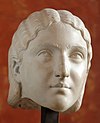
|
Sallustia Orbiana Gnaea Seia Herennia Sallustia Barbia Orbiana |
225 – 227 (2 years) |
Daughter of Lucius Seius Herennius Sallustius; exiled to Africa | Severus Alexander (r. 222–235) |
[26] |
Crisis of the Third Century (235–285)
All empresses during this period received the title augusta.
| Portrait | Name | Tenure | Life details & notes | Emperor (spouse) | Ref |
|---|---|---|---|---|---|

|
Caecilia Paulina | 235 (?) (very briefly?) |
Nothing known; most likely dead by the time Maximinus became emperor. She was deified by her husband. | Maximinus I (r. 235–238) |
[27] |

|
Fabia Orestilla (?) | 238 (?) (22 days?) |
Probably fictional. | Gordian I (r. 238) |
[28] |
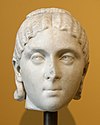
|
Tranquillina Furia Sabinia Tranquillina |
12 May (?) 241 – c. February 244 (2 years and a half) |
Daughter of Gaius Furius Sabinius Aquila Timesitheus; unknown fate. | Gordian III (r. 238–244) |
[29] |
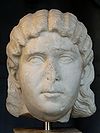
|
Marcia Otacilia Severa | 244 – 248 (?) (c. 4 years) |
Daughter or sister of a man called Severianus; nothing else known. | Philip (r. 244–249) |
[30] |

|
Herennia Etruscilla Herennia Cupressenia Etruscilla |
249 – 251 (2 years) |
Of a noble Etrurian descent. | Decius (r. 249–251) |
[31] |

|
Gaia Cornelia Supera | 253 (3 months) |
Nothing known. | Zdroj:https://en.wikipedia.org?pojem=List_of_Roman_and_Byzantine_empresses
